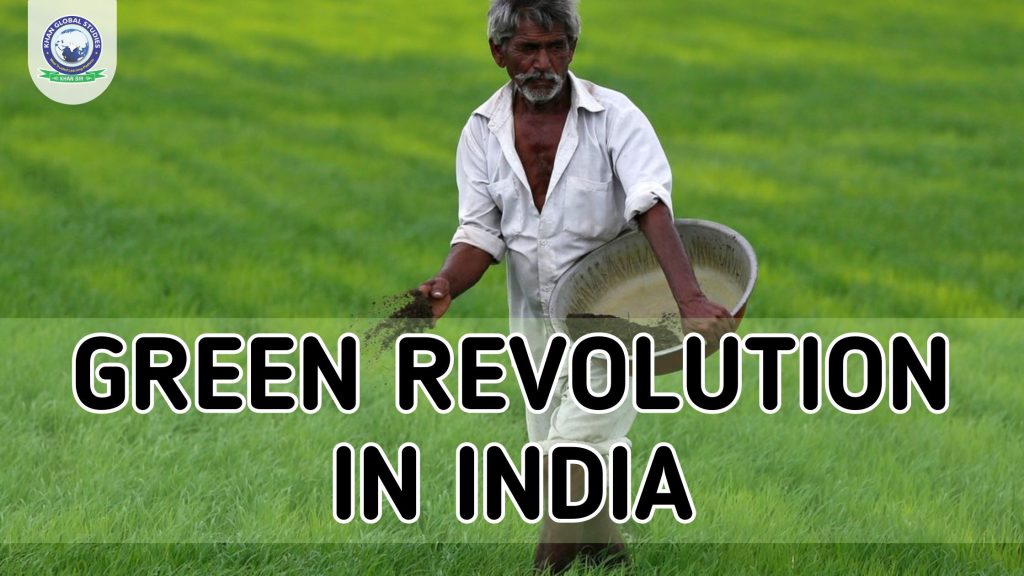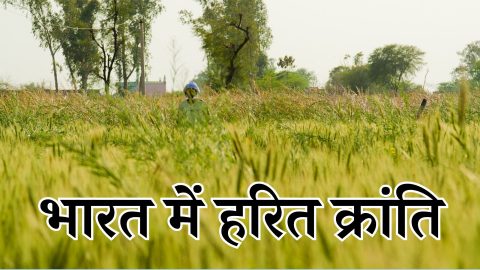The Green Revolution was an effort initiated in the 1960s by Norman Borlaug, who is widely known as the “Father of the Green Revolution”. In 1970, Borlaug was awarded the Nobel Peace Prize for his work in developing high-yielding varieties (HYVs) of crops.
In India, the Green Revolution was led primarily by M.S. Swaminathan. The result of the Green Revolution was a significant increase in the production of food grains, especially wheat and rice. This change began in the developing world in the mid-20th century due to the use of new, high-yielding seed varieties. The early successes of the Green Revolution were seen in Mexico and the Indian subcontinent. Between 1967–68 and 1977–78, the Green Revolution transformed India from a food-deficient country to one of the leading agricultural nations in the world.
Objectives of the Green Revolution
- Short Term: The Green Revolution was launched during the Second Five-Year Plan to overcome the problem of hunger in India.
- Long-term: The long-term objectives included rural development, modernization of agriculture based on industrial development, development of infrastructure and supply of raw materials.
- Employment: To employ workers in both agricultural and industrial sectors.
- Scientific Studies: To produce healthy plants capable of withstanding adverse climates and diseases.
- Globalization of Agriculture: To spread technology to non-industrial countries and encourage the establishment of corporations in major agricultural areas.
Key Elements of the Green Revolution
- Expansion of Agricultural Land: Although arable land had been expanding since 1947, it was not enough to meet the growing demand for food grains. The Green Revolution helped in the expansion of agricultural land.
- Double Cropping System: A primary feature of the Green Revolution was the adoption of the double cropping system, where two crops were grown in a year instead of one. This was facilitated by the construction of large irrigation projects and dams.
- Use of Improved Genetic Seeds: The scientific aspect of the Green Revolution was the use of advanced genetics (high-yielding varieties). The Indian Council of Agricultural Research developed new varieties of seeds for crops such as wheat, rice, millet and maize.
Main Crops Include
Main crops include wheat, rice, jowar, millet and maize. Non-food crops were excluded from the new strategy, while wheat remained the cornerstone of the Green Revolution for many years.
Background of Green Revolution in India
In 1943, India was one of the countries most affected by food crises, with the Bengal famine killing about 4 million people in eastern India. After independence in 1947, the government focused on large-scale expansion of agricultural areas until 1967. However, population growth outpaced food production, necessitating immediate and drastic action, leading to the emergence of the Green Revolution. The Green Revolution in India refers to the period when Indian agriculture transformed into an industrial system due to the adoption of modern techniques and technologies such as high-yielding seed varieties, tractors, irrigation facilities, pesticides, and fertilizers. It was funded by the Government of India and the Ford and Rockefeller Foundations. The Green Revolution in India is primarily a wheat revolution, with wheat production increasing more than threefold between 1967-68 and 2003-04, while total grain production only doubled.
Positive Effects of the Green Revolution
- Increase in Crop Production: By 1978-79, grain production reached 131 million tonnes, making India one of the largest agricultural producers in the world.
- Reduction in Food Grain Imports: India became self-sufficient in food grains with adequate stocks in the central pool, and even started exporting food grains.
- Benefits to Farmers: Farmers’ income levels increased, and surplus income was reinvested to improve agricultural productivity. Large farmers with more than 10 hectares of land benefited from significant investments in inputs such as HYV seeds, fertilizers and machinery, particularly, thereby promoting capitalist farming.
- Industrial Development: The Green Revolution led to large-scale agricultural mechanization, increasing the demand for tractors, harvesters, threshers, combines, diesel engines, electric motors and pumping sets. The demand for chemical fertilizers, insecticides and herbicides also increased significantly.
- Rural Employment: The demand for labour increased significantly due to multi-cropping and fertilizer use. The Green Revolution created various employment opportunities for agricultural and industrial workers through the construction of facilities related to factories and hydropower stations.
Negative Effects of the Green Revolution:
- Exclusion of Non-Food Grains: Although the Green Revolution saw increased production in wheat, rice, jowar, bajra and maize, other crops such as coarse cereals, pulses and oilseeds were excluded.
- Limited Coverage of HYVP: The High Yielding Varieties Programme (HYVP) was limited to five crops: wheat, rice, jowar, bajra and maize. Non-food crops were outside the scope of the new strategy, and HYV seeds for non-food crops were either underdeveloped or farmers were unwilling to take the risk of using them.
- Regional Disparities: Green Revolution technology increased economic disparities at intra-regional and inter-regional levels. Its impact was observed mainly in northern regions such as Punjab, Haryana and western Uttar Pradesh and southern regions such as Andhra Pradesh and Tamil Nadu. Its impact was minimal in eastern regions including Assam, Bihar, West Bengal and Odisha as well as arid and semi-arid regions of western and southern India. The Green Revolution benefited regions that were already agriculturally better off, thereby increasing regional inequalities.
- Excessive use of Chemicals: The Green Revolution led to the large-scale use of pesticides and synthetic nitrogen fertilizers. Farmers were not educated about the high risks associated with the intensive use of pesticides. Untrained labourers often use pesticides without following instructions or precautions, causing great damage to crops and contributing to environmental and soil pollution.
- Water Consumption: The crops introduced in the Green Revolution were water-intensive. Most of these crops required about 50% of the water supply. The introduction of canal systems and the increased use of irrigation pumps further depleted groundwater levels. Intensive irrigation of water-intensive crops such as sugarcane and rice caused groundwater levels to fall, making Punjab, a major wheat and rice growing region, one of the most water-stressed regions in India.
- Effects on Soil and Crop Production: Continuous adoption of the same crop cycle to ensure higher production led to the depletion of nutrients in the soil. Farmers used more fertilizers to meet the need for new seed varieties. The use of these alkaline chemicals increases the pH level of the soil. The use of toxic chemicals in the soil destroyed beneficial microorganisms, reducing the yield.
- Unemployment: Agricultural mechanization under the Green Revolution led to widespread unemployment among farm labourers in rural areas except in Punjab and to some extent Haryana. The poorest and landless labourers were the worst affected.
- Effects on health: Large-scale use of chemical fertilizers and pesticides such as phosphamidone, methomyl, triazophos and monocrotophos led to serious health problems such as cancer, kidney failure, stillbirths and birth defects.
Key features of the Green Revolution
- Use of High-Yielding Variety (HYV) Seeds: Developed by agricultural scientists like M.S. Swaminathan, who is considered the father of the Green Revolution in India.
- Irrigation Methods: Adoption of various irrigation methods like tube wells, canals, dams and sprinklers to reduce dependence on rainfall and ensure regular water supply to crops.
- Mechanization of Major Agricultural Practices: Use of machinery like tractors, harvesters and drills for ploughing, sowing, harvesting and threshing to reduce labour costs and increase efficiency.
- Use of Chemical Fertilizers and Pesticides: To increase soil fertility and protect crops from pests and diseases.
- Double Cropping System: Growing two crops in a year in the same field to increase cropping intensity and yield.
- Expansion of Agricultural Area: Bringing more land under cultivation using irrigation and HYV seeds, especially in semi-arid and arid regions.
Challenges Posed by Green Revolution
- Environmental Degradation: The use of synthetic fertilizers and pesticides led to soil erosion and water pollution. Dependence on modern agricultural technologies made some countries and communities dependent on expensive external inputs, which were subject to market fluctuations.
- Loss of Biodiversity: Loss of genetic diversity in crops and displacement of native crops and traditional agricultural practices. While wheat and rice production doubled, cultivation of other food crops such as native rice varieties and coarse grains declined.
- Social and Economic Inequalities: The Green Revolution led to social and economic inequalities and conflicts between farmers and regions. In India, this is associated with farmer suicides, rural indebtedness, and frequent droughts.
- Increased vulnerability to pests, diseases, and climate change: Monoculturing of crops such as rice and wheat made them more vulnerable to outbreaks of pests and diseases such as brown plant hopper and wheat rust.
Conclusion
Overall, the Green Revolution was a significant achievement in ensuring national food security for many developing countries, especially India. It represents the successful adaptation and transfer of the scientific revolution in agriculture already implemented in industrialized countries. However, the focus was primarily on food security, while other factors such as the environment, poor farmers, and educating them about chemical use received less attention. Going forward, policymakers should target the poor more precisely to ensure that they receive more direct benefits from new technologies and adopt environmentally sustainable practices. Additionally, future initiatives should cover a wider range of areas to benefit all sectors.





